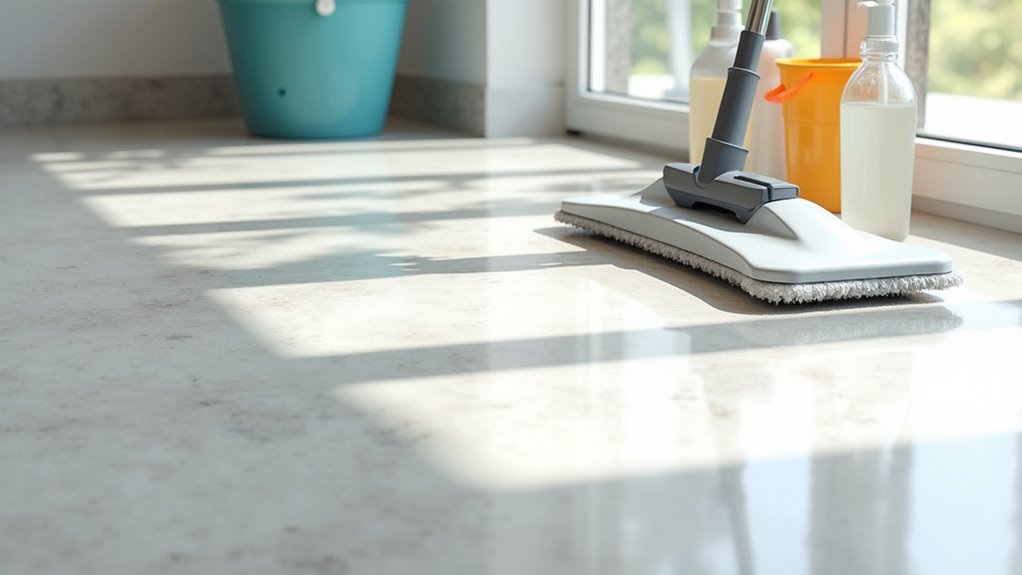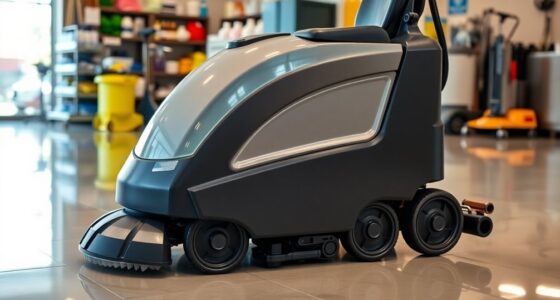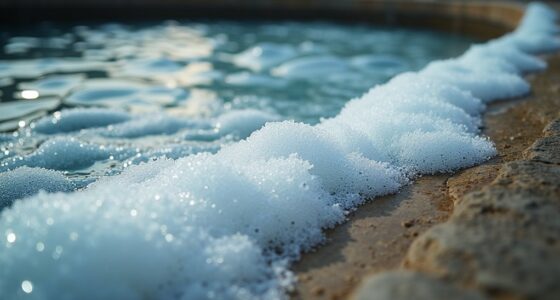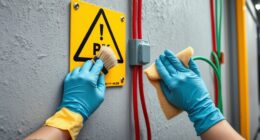To keep your polished concrete looking its best, you should start with gentle daily care by sweeping or vacuuming to remove grit, then lightly dampen soft scrubbers with water or a pH-neutral cleaner for surface cleaning. Weekly, perform a deeper scrub using soft pads or brushes and clean your equipment thoroughly. Monthly, inspect the surface for wear, consider resealing if needed, and replace worn scrubber parts. Continuing with these routines helps maintain a pristine finish and extends the lifespan of your surface.
Key Takeaways
- Use soft-bristled or microfiber scrubbers with water or pH-neutral cleaner for daily cleaning.
- Perform a deeper weekly scrub with gentle machines to remove stubborn stains and residues.
- Regularly inspect and replace worn scrubber pads or brushes to maintain effective cleaning.
- Clean equipment after use to prevent dirt transfer and ensure longevity.
- Monthly, assess surface condition for dullness or damage; consider professional polishing or sealing if needed.
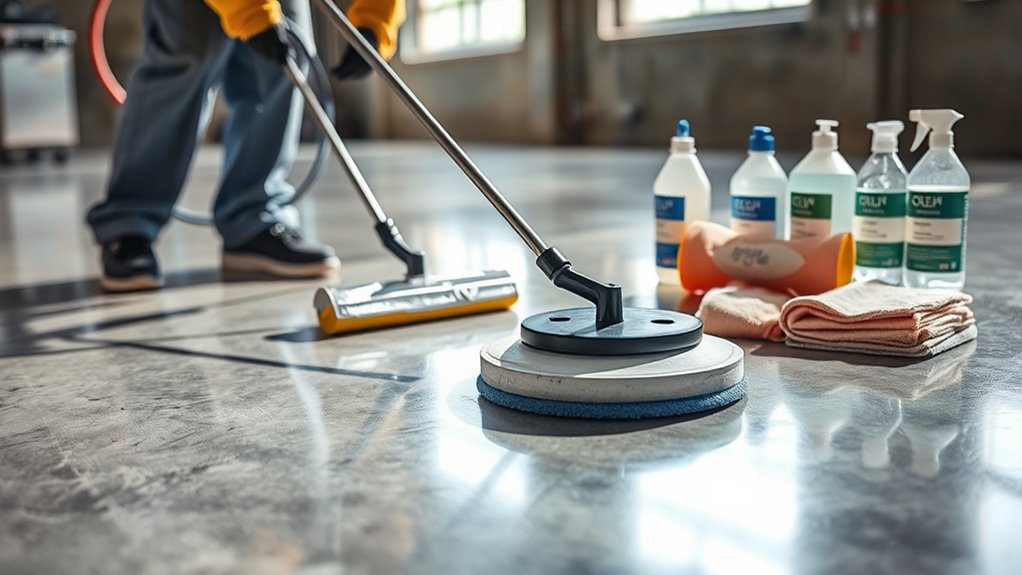
Are you guaranteeing your polished concrete stays its best with proper scrubber care? Maintaining the pristine appearance of polished concrete requires consistent attention to maintenance routines and well-planned cleaning schedules. Your daily cleaning habits lay the foundation for long-term durability, while weekly and monthly tasks help address buildup and wear that can’t be tackled with everyday care. By sticking to a structured routine, you prevent damage and keep your floors looking flawless.
Every day, your goal should be to keep the surface free of dirt, dust, and debris. Use a soft-bristled or microfiber scrubber attachment to gently remove surface particles without scratching or dulling the finish. Incorporate sweeping or vacuuming into your daily maintenance routines to prevent grit from accumulating and causing abrasions. When necessary, lightly dampen the scrubber with water or a pH-neutral cleaner designed for polished concrete. Avoid harsh chemicals that can degrade the surface or leave residues, which could compromise the shine over time. Regularly inspect the scrubber for signs of wear or clogging, replacing or cleaning the pad as needed to guarantee effective cleaning without damaging the surface. Additionally, choosing the right cleaning tools is essential for maintaining the integrity of the polished finish.
Daily, use soft or microfiber scrubbers to gently clean and prevent damage to polished concrete surfaces.
Your weekly cleaning schedule should be more thorough. This includes a deeper scrub to remove any stubborn stains or residues that may have settled into the surface. Use a neutral cleaner compatible with polished concrete, and consider utilizing a machine with a soft pad or brush to evenly distribute cleaning efforts. Pay special attention to high-traffic areas, which tend to accumulate more dirt and require extra attention. During weekly maintenance routines, also check for any signs of surface dullness or minor scratches. If you notice dullness, a light polishing with a suitable buffer can restore the shine without risking damage. Regularly clean your scrubber equipment after each use to prevent dirt and debris from transferring back onto the floor, maintaining ideal cleaning performance.
Monthly care involves inspecting the overall condition of your polished concrete and your scrubber equipment. Consider performing a professional polishing if the surface begins to lose its gloss or if there are visible scratches and etching. This helps maintain the aesthetic quality and extends the lifespan of your flooring. Additionally, check your cleaning tools and replace worn pads or brushes to guarantee you’re not inadvertently causing damage. Periodically, apply a concrete sealer or protector if your floors are exposed to heavy traffic or chemical spills—this adds a layer of defense and preserves the polished look. Incorporate these monthly tasks into your maintenance routines to keep your floors in top shape and guarantee your scrubber remains effective and safe to use.
Frequently Asked Questions
How Often Should I Adjust My Scrubber’s Settings for Different Stains?
You should modify your scrubber’s settings whenever you encounter different stains. The adjustment frequency depends on the stain type and severity, so don’t hesitate to change to stain-specific settings when needed. For minor stains, slight adjustments may suffice, but for tougher or unusual stains, you might need to recalibrate more often. Regularly evaluating the stain’s impact helps ensure effective cleaning without damaging your polished concrete surface.
Can Using Harsh Chemicals Damage Polished Concrete Surfaces?
Using harsh chemicals is like pouring acid on your polished concrete’s delicate skin; it can cause chemical damage and surface etching. These aggressive substances strip away the finish, dulling the shine and weakening the surface. To protect your investment, stick to pH-neutral cleaners and avoid harsh acids or alkalis. Proper care keeps your polished concrete looking stunning, not scarred by chemical damage.
What Are Signs That My Scrubber Needs Maintenance or Parts Replacement?
You’ll notice your scrubber needs maintenance if the battery isn’t holding a charge or the machine struggles to operate longer than usual. Watch for increased brush wear, which reduces cleaning efficiency, and listen for unusual noises. If the scrubber’s performance declines despite regular use, it’s time to check the battery and replace worn brushes. Addressing these signs promptly keeps your equipment running smoothly and prolongs its lifespan.
How Do I Prevent Streaks or Haziness After Cleaning?
To prevent streaks or haziness on your polished concrete, you should use streak prevention techniques like ensuring your scrubber is properly calibrated and using the right cleaning solutions. Always rinse thoroughly to remove residue and avoid over-wetting the surface. Regularly maintain your equipment and clean the pads or brushes. These steps help preserve your polished concrete aesthetics, leaving it glossy and streak-free after each cleaning.
Are There Eco-Friendly Scrubber Options Suitable for Polished Concrete?
Imagine a cleaner world—eco-friendly options do exist for your polished concrete. You can choose biodegradable scrubbers, which break down naturally without harming the environment. These eco-friendly cleaning tools are gentle yet effective, helping you maintain your surface’s shine while reducing your carbon footprint. By opting for biodegradable scrubbers, you embrace sustainable practices that protect your space and the planet, making every clean a step toward a greener future.
Conclusion
Keep your polished concrete looking its best with consistent scrubber care. For instance, imagine a busy retail store that used daily and weekly maintenance to maintain its sleek floors, impressing customers and reducing long-term repairs. Regular cleaning not only enhances appearance but also extends the lifespan of your concrete. By sticking to a tailored schedule, you’ll enjoy shiny, durable floors that stand up to daily wear—saving you time and money in the long run.
